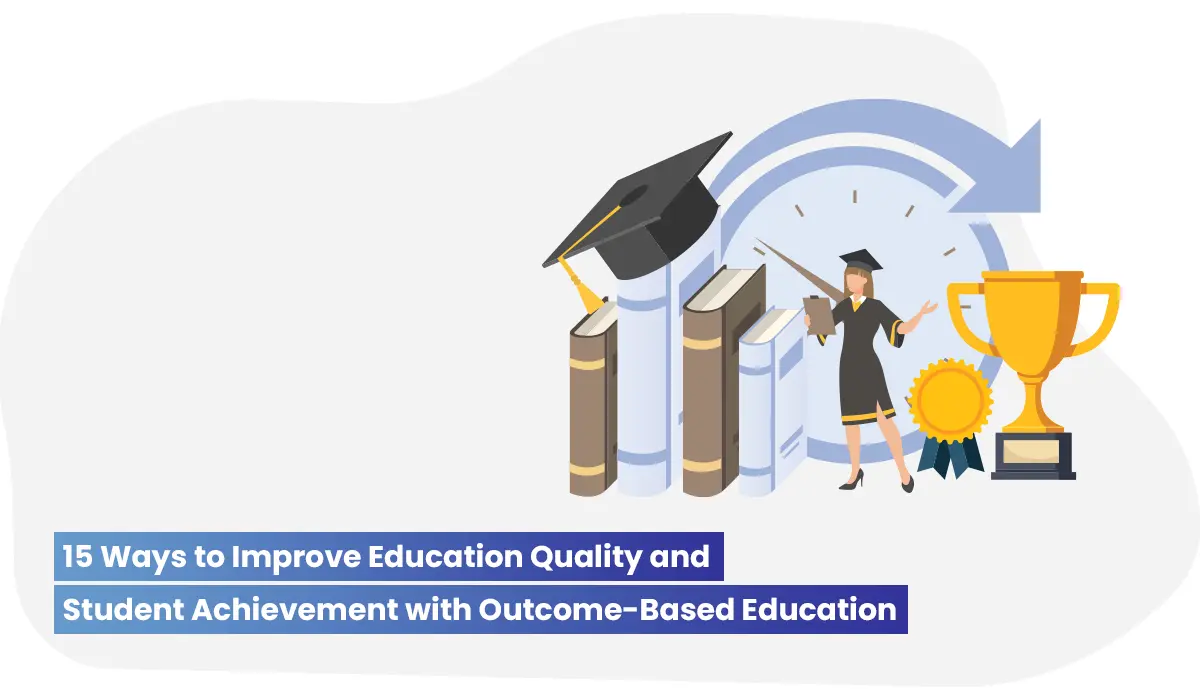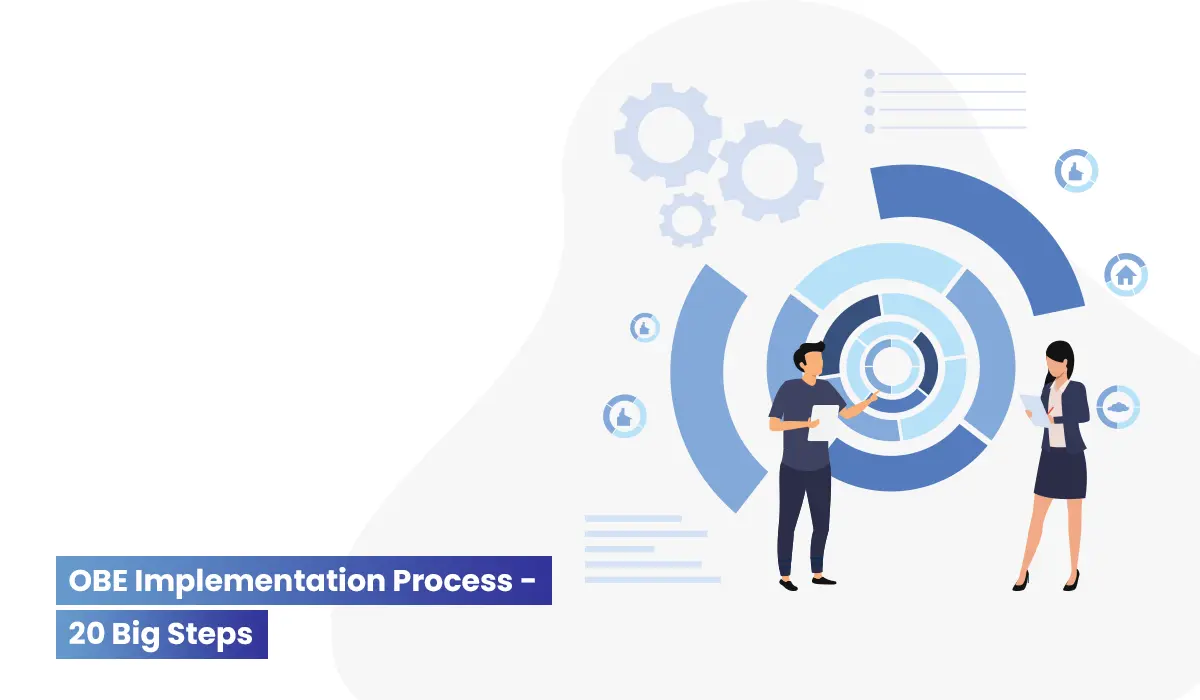Designing Effective Learning Outcomes with Solo Taxonomy in Higher Education

Education plays a pivotal role in shaping the knowledge, skills, and competencies of students, and learning outcomes serve as a critical component of the educational process. Learning outcomes outline the expected achievements and competencies students should acquire upon completion of a course or program.
To ensure that learning outcomes are meaningful, measurable, and aligned with the desired educational goals, educators often employ various frameworks and models. One such framework gaining prominence in higher education is the Solo Taxonomy. Let's explore the concept of Solo Taxonomy and delve into how it can be used to design effective learning outcomes in the context of higher education in this blog.
What is Solo Taxonomy?
Solo Taxonomy is a hierarchical framework developed by John Biggs and Kevin Collis for designing and assessing learning outcomes. It categorizes levels of understanding and competence based on the complexity of students' thinking and application of knowledge. It consists of five levels:
- pre-structural
- Uni-structural
- Multi-structural
- Relational
- Extended abstract

Understanding the Five Levels of Solo Taxonomy
Solo Taxonomy consists of five levels that describe the stages of understanding and competence in learning. These levels provide a framework for educators to design and assess learning outcomes. Here is an overview of the five levels of Solo Taxonomy:
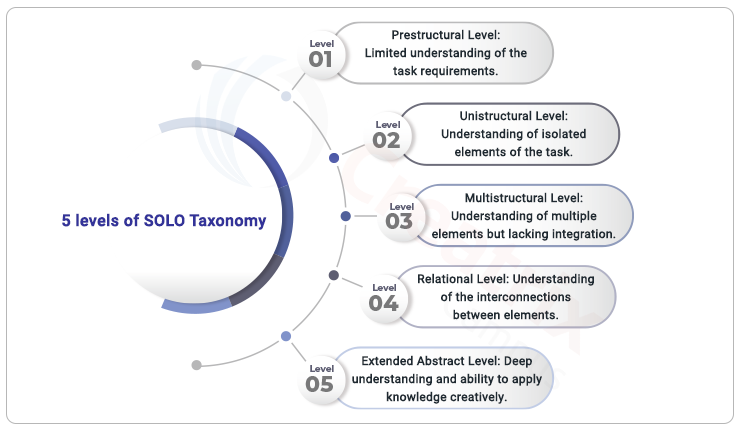
Pre-structural
At this level, learners have minimal or no understanding of the topic. They may lack the necessary knowledge or skills to engage with the subject matter.
Uni-structural
Learners at this level have a basic understanding of isolated facts or concepts. They can identify and recall information but struggle to make connections or apply their knowledge in a meaningful way.
Multi-structural
This level involves a more comprehensive understanding of the topic. Learners can organize and connect multiple facts or concepts but may still struggle to see the bigger picture or transfer their knowledge to different contexts.
Relational
At this level, learners can make connections between different ideas, concepts, or domains. They can analyze and explain relationships, compare and contrast information, and apply their knowledge in diverse contexts.
Extended Abstract
This is the highest level of Solo Taxonomy. Learners at this stage demonstrate a deep and sophisticated understanding of the topic. They can think critically, evaluate information, create new insights, and transfer their knowledge to complex and unfamiliar situations.
Benefits of Using Solo Taxonomy for Learning Outcomes Design
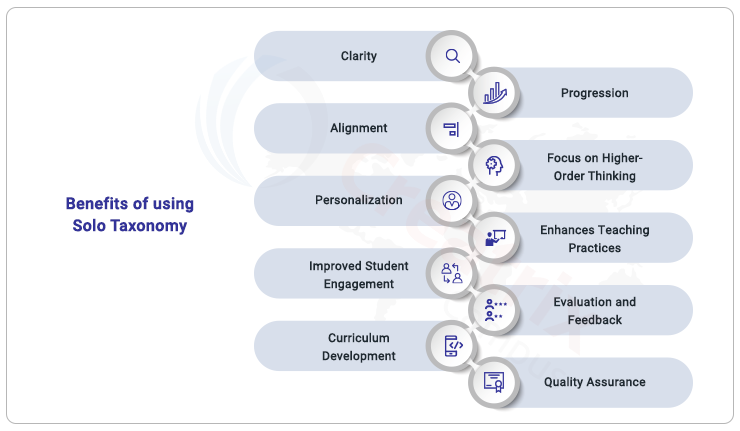
Using Solo Taxonomy for learning outcomes design offers several benefits that enhance the effectiveness of teaching and learning.
Here are some key benefits:
Clarity and Structure
Solo Taxonomy provides a clear and structured framework for designing learning outcomes. It helps educators specify the desired level of understanding and competence, enabling them to create focused and measurable objectives.
Progression of Learning
The five levels of Solo Taxonomy allows for the progressive development of knowledge and skills. By designing learning outcomes that span the different levels, educators can scaffold learning experiences and guide students towards higher levels of thinking and understanding.
Alignment with Bloom's Taxonomy
Solo Taxonomy aligns well with Bloom's Taxonomy, which is a widely recognized framework for categorizing learning objectives. By using Solo Taxonomy alongside Bloom's Taxonomy, educators can ensure that learning outcomes encompass both cognitive processes and levels of understanding.
Improved Assessment
Practices Solo Taxonomy facilitates effective assessment practices by providing a clear reference point for evaluating students' progress. It enables educators to design assessments that align with the intended learning outcomes, making it easier to measure students' understanding and competence accurately.
Enhanced Student Engagement
Solo Taxonomy promotes active student engagement and ownership of learning. By clearly defining the expected levels of understanding, students can better grasp their learning goals and actively work towards achieving them. This promotes self-reflection, self-assessment, and self-directed learning.
Personalized Learning
Solo Taxonomy allows educators to tailor learning outcomes to the specific needs and abilities of individual students. By designing differentiated objectives, educators can provide targeted instruction and support, fostering personalized learning experiences.
Transferable Skills
The higher levels of Solo Taxonomy, such as relational and extended abstract thinking, promote the development of critical thinking, problem-solving, and transferable skills. Students are better equipped to apply their knowledge and skills in real-world contexts, preparing them for future academic and professional endeavors.
Steps to Designing Learning Outcomes with Solo Taxonomy

Designing learning outcomes with Solo Taxonomy involves several steps to ensure clarity, progression, and alignment with the desired learning goals. Here are the steps to follow:
Identify the Subject or Topic
Determine the subject or topic for which you want to design learning outcomes. It could be a specific concept, skill, or area of knowledge.
Understand the Five Levels
Familiarize yourself with the five levels of Solo Taxonomy - pre-structural, uni-structural, multi-structural, relational, and extended abstract. Gain a clear understanding of what each level represents in terms of understanding and competence.
Determine the Desired Level
Determine the desired level of understanding and competence for your learning outcomes. Consider the complexity of the subject matter and the cognitive demands you want to place on students.
Write Learning Outcomes
Write clear, specific, and measurable learning outcomes for each level of Solo Taxonomy. Start with the lower levels and progress towards the higher levels to ensure a logical and scaffolded progression of learning.
Use Action Verbs
Use action verbs that correspond to each level of Solo Taxonomy. For example, for the pre-structural level, use verbs like "identify" or "define," while for the extended abstract level, use verbs like "evaluate" or "synthesize." This helps articulate the intended level of thinking and understanding.
Align with Bloom's Taxonomy
Consider aligning your learning outcomes with Bloom's Taxonomy to ensure a comprehensive approach to learning. Map the levels of Solo Taxonomy with the cognitive processes of Bloom's Taxonomy to create a well-rounded set of learning outcomes.
Review and Refine
Review the learning outcomes to ensure they are clear, concise, and aligned with the desired level of understanding. Revise and refine as needed to enhance their effectiveness.
Communicate and Share
Communicate the learning outcomes with students, colleagues, and other stakeholders. Ensure that everyone involved understands the expectations and goals of the learning process.
Incorporate Assessments
Develop appropriate assessment methods and criteria to measure students' progress and achievement of the learning outcomes. Align the assessments with the desired levels of Solo Taxonomy to ensure accurate evaluation.
Reflect and Iterate
Regularly reflect on the effectiveness of the learning outcomes and make necessary adjustments based on student performance and feedback. Continuously iterate and improve the learning outcomes to enhance student learning and achievement.
Examples of Learning Outcomes with Solo Taxonomy
Learning outcomes designed using Solo Taxonomy encompass various levels of cognitive complexity, from multi-structural to metacognitive. The assessment strategies are aligned with these levels, ensuring that students' abilities to think, analyze, evaluate, and create are appropriately assessed according to the desired taxonomy level. Let’s take a look at some examples below.
Course: Introduction to Biology
Learning Outcome (Level 3 - Relational): Students will be able to compare and contrast different organisms based on their characteristics and evolutionary relationships.
Assessment Strategy: Students will participate in a laboratory activity where they have to analyze and evaluate the similarities and differences between various organisms, demonstrating their ability to apply relational thinking.
Course: Marketing Management Learning
Outcome (Level 4 - Extended Abstract): Students will be able to create innovative marketing strategies by synthesizing their understanding of consumer behavior and market trends.
Assessment Strategy: Students will work on a marketing research project where they gather and analyze data, and then propose a unique and creative marketing strategy that goes beyond the existing knowledge, showcasing their ability to think at an extended abstract level.
Course: Introduction to Programming
Learning Outcome (Level 2 - Multistructural): Students will be able to identify and implement appropriate algorithms to solve programming problems.
Assessment Strategy: Students will complete a coding assignment where they have to apply the predefined algorithms to solve given programming problems, demonstrating their ability to use multi-structural thinking in programming tasks.
Course: Ethics in Business
Learning Outcome (Level 5 - Metacognitive): Students will be able to critically evaluate complex ethical dilemmas in business situations, reflect on their own ethical reasoning process, and propose comprehensive and ethically justified solutions.
Assessment Strategy: Students will participate in a class discussion or debate where they analyze and evaluate challenging ethical dilemmas, engaging in metacognitive thinking by reflecting on their ethical decision-making processes and proposing well-reasoned solutions.
Challenges and Limitations
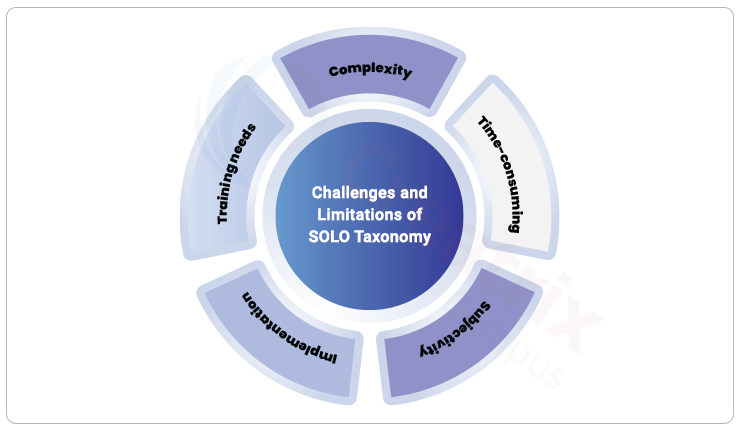
While Solo Taxonomy offers numerous benefits for designing learning outcomes, it also has its challenges and limitations. These include
Subjectivity:
The interpretation of Solo Taxonomy levels can be subjective, leading to variations in understanding and application. Different educators may have different perspectives on the level at which a learning outcome aligns.
Overreliance on surface-level understanding:
Solo Taxonomy primarily focuses on the cognitive levels of understanding, potentially overlooking other aspects such as affective and psychomotor domains. This limitation may limit the holistic development of students.
Simplification of complex learning:
Solo Taxonomy tends to simplify the complexity of learning by categorizing it into discrete levels. However, real-world learning is often multidimensional and interconnected, making it challenging to neatly fit into distinct categories.
Limited guidance on assessment methods:
While Solo Taxonomy provides guidance on designing learning outcomes, it offers limited guidance on appropriate assessment methods for each level. Educators need to align assessment strategies carefully to ensure accurate evaluation of student's cognitive abilities.
Potential rigidity in curriculum design:
Solely relying on Solo Taxonomy for curriculum design may lead to a rigid approach, potentially hindering flexibility and adaptability to meet evolving educational needs and diverse learner profiles.
Lack of emphasis on creativity and innovation:
Solo Taxonomy primarily focuses on understanding and applying existing knowledge. It may not explicitly address the higher-level skills of creativity, innovation, and problem-solving, which are crucial in today's rapidly changing world.
Despite these challenges and limitations, Solo Taxonomy can still serve as a valuable framework for designing learning outcomes. Educators should be aware of these limitations and supplement their instructional approaches with other pedagogical strategies to create a well-rounded learning experience for students.
Bloom’s Taxonomy vs Solo Taxonomy
The comparison table showcasing the key differences between Bloom's Taxonomy and Solo Taxonomy:

Please note that this table provides a concise overview of the differences between the two taxonomies. The actual frameworks are more detailed and nuanced, encompassing specific cognitive processes and learning outcomes.
Conclusion
Designing effective learning outcomes using Solo Taxonomy is a powerful approach that promotes deep understanding and enhances student learning. By leveraging the benefits of Solo Taxonomy, educators can create clear and progressive learning outcomes that align with assessment strategies and facilitate meaningful learning experiences.
To further optimize the process of designing and mapping learning outcomes, Creatrix Campus offers a comprehensive solution with its SOLO Taxonomy Mapping in Outcome-Based Education software. With this innovative software, educators can seamlessly integrate Solo Taxonomy into their curriculum development process, align learning outcomes with the appropriate taxonomy levels, and track student progress effectively.
Take your curriculum development to the next level with Creatrix Campus SOLO Taxonomy Mapping in Outcome-Based Education software. Visit our website today to learn more about how our software can empower your institution in designing and mapping effective learning outcomes.

